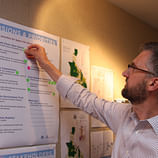
In 1990, we founded Moule & Polyzoides, Architects and Urbanists with the goal of providing our clients the highest standard of comprehensive architectural services. To do so, we realized that we had to forge a new approach to architecture, landscape architecture, and urbanism, one that reunites and redefines these now separate aspects of design practice.
Since the 1970s, architectural culture has become increasingly divided between two factions, each group holding ideals and views exclusive of the other. At one end, proponents who embrace the Modernist legacy claim that the architect's role is to invent ever new and monumental forms. At the other, proponents of historical continuity assert that the cultural rifts of this century can be mended only by replicating traditional architectural forms.
We believe there is a third way. We are convinced that the visual chaos, formlessness, and placelessness of today's cities and suburbs can be rectified only if architects occupy a middle ground, one that supports both newness and continuity. In our view, knowledge of architectural history need not lead to reproductions of the past, but rather to the subtle transformation of its precedents. By respecting precedent, each project can be the starting point for further design that bestows formal and historical continuity. Only in this sense can newness be synonymous with cultural changes that enrich rather than estrange.
Central to our practice is the idea of coherence. The community bonds necessary to sustain family and civic life can flourish only in such coherently formed environments. Each project is developed as an integral part of a larger order. Whether a building, square, streetscape or landscape, it is seen as part of an urban or natural pattern and contributing to the form of a larger, understandable whole. For this reason, we co-founded with four other like-minded architects the Congress for the New Urbanism, a national organization dedicated to reconstructing the American metropolis and preserving natural resources. We also co-wrote the Ahwahnee Principles, a set of new community planning guidelines for the State of California. In both forums and in our work, we have promoted the imperative of linking community with sustainability in town-making and architecture.
All of our projects are informed by our understanding of architectural history and regional building traditions, consideration of existing urban settings, respect for the functional and spiritual purposes of architecture, and sensitivity to place and fragility of natural ecosystems. We both invite you to talk with us about this exciting future.
Elizabeth Moule and Stefanos Polyzoides


